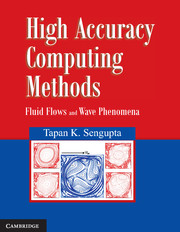Book contents
- Frontmatter
- Contents
- Foreward
- Preface
- Chapter 1 Basic Ideas of Scientific Computing
- Chapter 2 Governing Equations in Fluid Mechanics
- Chapter 3 Classification of Quasi-Linear Partial Differential Equations
- Chapter 4 Waves and Space–Time Dependence in Computing
- Chapter 5 Spatial and Temporal Discretizations of Partial Differential Equations
- Chapter 6 Solution Methods for Parabolic Partial Differential Equations
- Chapter 7 Solution Methods for Elliptic Partial Differential Equations
- Chapter 8 Solution of Hyperbolic PDEs: Signal and Error Propagation
- Chapter 9 Curvilinear Coordinate and Grid Generation
- Chapter 10 Spectral Analysis of Numerical Schemes and Aliasing Error
- Chapter 11 Higher Accuracy Methods
- Chapter 12 Introduction to Finite Volume and Finite Element Methods
- Chapter 13 Solution of Navier–Stokes Equation
- Chapter 14 Recent Developments in Discrete Finite Difference Computing
- Exercises
- References
- Index
Chapter 12 - Introduction to Finite Volume and Finite Element Methods
Published online by Cambridge University Press: 05 January 2014
- Frontmatter
- Contents
- Foreward
- Preface
- Chapter 1 Basic Ideas of Scientific Computing
- Chapter 2 Governing Equations in Fluid Mechanics
- Chapter 3 Classification of Quasi-Linear Partial Differential Equations
- Chapter 4 Waves and Space–Time Dependence in Computing
- Chapter 5 Spatial and Temporal Discretizations of Partial Differential Equations
- Chapter 6 Solution Methods for Parabolic Partial Differential Equations
- Chapter 7 Solution Methods for Elliptic Partial Differential Equations
- Chapter 8 Solution of Hyperbolic PDEs: Signal and Error Propagation
- Chapter 9 Curvilinear Coordinate and Grid Generation
- Chapter 10 Spectral Analysis of Numerical Schemes and Aliasing Error
- Chapter 11 Higher Accuracy Methods
- Chapter 12 Introduction to Finite Volume and Finite Element Methods
- Chapter 13 Solution of Navier–Stokes Equation
- Chapter 14 Recent Developments in Discrete Finite Difference Computing
- Exercises
- References
- Index
Summary
Introduction
We have discussed in Chapter 11 about classes of high accuracy compact finite difference schemes for spatial discretization, which along with time discretization schemes, can be used for DNS. It was noted using spectral analysis that the performance of any numerical method is best judged by the spatial and temporal resolutions provided by the combined analysis rather than by the formal order of truncation error terms of individually discretized terms. In this respect, a few compact difference methods are preferred over explicit methods, due to computational efficiency and accuracy. Higher efficiency is due to lesser requirements of points due to higher resolution and accuracy is due to implicit satisfaction of physical dispersion relation with larger time step. It was seen that two second order methods proposed [104, 260, 277], provided higher resolution than sixth order methods [2, 360]. In [104, 277], higher resolution schemes were obtained by minimizing L2-norm of solution error, evaluated as difference of numerical solution from exact solution in the Fourier spectral space for solving 1D convection equation.
There is no unique procedure for the Padè schemes, relating derivative(s) and function values at the nodes. While this can provide flexibility in the choice of a method, if sufficient care is not taken, then it may lead to inconsistency. FVM and FEM can be viewed in this respect to provide logical development in obtaining discrete equations based on physical statement of the problem. Both these methods and other integral methods are said to satisfy conservation principles in a weak sense. In FVM, physical conservation processes are fulfilled in a finite control volume. Physical “densities” of conserved properties are related to fluxes entering and leaving the control volume through control surfaces. These fluxes are created and governed by physical convection and diffusion processes, along with pressure gradient and body forces.
Information
- Type
- Chapter
- Information
- High Accuracy Computing MethodsFluid Flows and Wave Phenomena, pp. 341 - 404Publisher: Cambridge University PressPrint publication year: 2013
